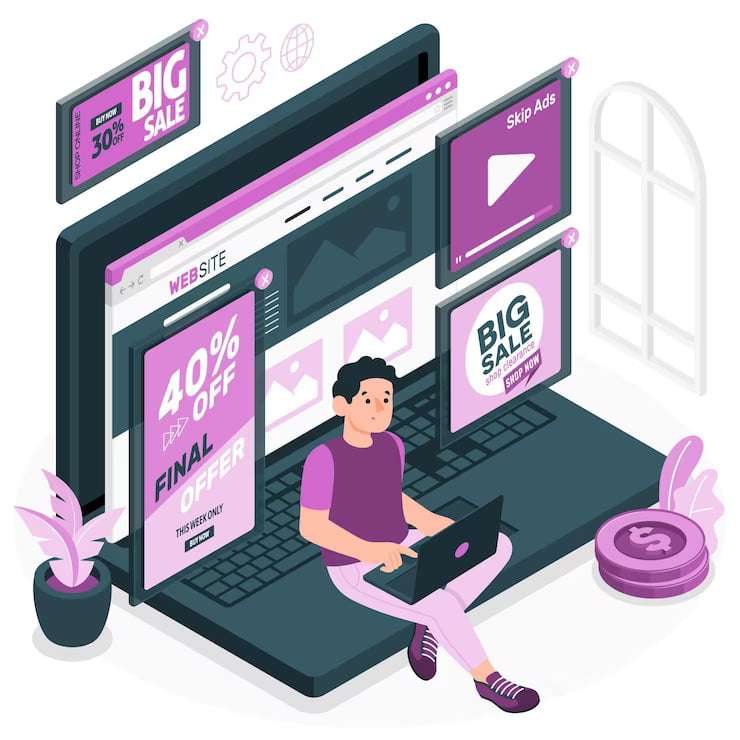#1 Digital Marketing Services. Lets gets connected and talk to grow your business with our data-driven digital marketing services.
#1Digital Marketing Services to help businesses establish their online presence and get sales and leads quicker to build their brand. Explore all our online marketing services today
Digital Marketing Services
We have expertise in all types of online Marketing and development services.

Web Development
We build all types of website that drives conversion.

App Development
Create app that helps customer to connect with your product easily.

UI/UX Design
Enhance customer experience at the website and application with better UI.

Search Engine Optimization
Maximize your search traffic with our SEO experts.

Pay-Per-Click Advertising
Drive conversion and traffic to your website and application with our PPC especialists.

Social Media Marketing
Create brand with highly engaging social media campaigns.

Content Marketing
Increase reach of your content with content marketing to increase your presence in market.

Email Marketing
Create Email Campaigns and connect with customers easily

Conversion Rate Optimization
Increase your conversions and better ROI with our CRO experts.

Ecommerce
We create and manage ecommerce website that generate traffic and sales.

Marketplace Management
Sell your product with marketplace. Generate More Revenue

Automation
Automate your marketing campaigns and customer interaction with us.

Digital Marketing Training
Looking for a Internet Marketing Institute. We are here to train you for future of marketing

Maketing Audit
Audit your intenal marketing campaigns and get your competitors analysis for growth.

Market Research
Discover the new products and market that will be a next big thing in future.

Bring growth to business
Lets talk to increase your sales.
WHAT WE DO
Don't be afraid to give up the good to go for the great
App Development
Far far away, behind the word moun far from the countries Vokalia Place supplies with regelialia.
Design & Development
Far far away, behind the word moun far from the countries Vokalia Place supplies with regelialia.
Innovative Solutions
Far far away, behind the word moun far from the countries Vokalia Place supplies with regelialia.
App Development
Far far away, behind the word moun far from the countries Vokalia Place supplies with regelialia.
Design & Development
Far far away, behind the word moun far from the countries Vokalia Place supplies with regelialia.
Innovative Solutions
Far far away, behind the word moun far from the countries Vokalia Place supplies with regelialia.

Pricing Plan
Choose Pricing Plan
For More information
Talk TO Us Now
Need Help?
FAQs
what is a digital marketing service?
Digital marketing services refer to the strategies, techniques, and activities employed by businesses and organizations to promote their products, services, or brand using digital channels and platforms. In today’s technologically advanced world, digital marketing has become an essential component of any successful marketing campaign. This form of marketing allows businesses to reach a vast online audience, engage with potential customers, and drive desired outcomes, such as sales, leads, or brand awareness.
Digital marketing services encompass a wide range of activities, each aimed at achieving specific marketing objectives. Some of the key services within digital marketing include search engine optimization (SEO), search engine marketing (SEM), social media marketing (SMM), content marketing, email marketing, influencer marketing, and analytics. Let’s explore each of these services in more detail:
Search Engine Optimization (SEO): SEO involves optimizing a website’s content, structure, and technical elements to improve its visibility in search engine results. By implementing relevant keywords, improving website speed, enhancing user experience, and acquiring high-quality backlinks, businesses can increase their organic search rankings and drive more traffic to their websites.
Search Engine Marketing (SEM): SEM involves paid advertising on search engines, primarily through platforms like Google Ads. It allows businesses to bid on keywords related to their products or services and display ads in search engine results. SEM offers quick visibility and targeted reach, helping businesses drive immediate traffic to their websites.
Social Media Marketing (SMM): SMM focuses on leveraging social media platforms like Facebook, Instagram, Twitter, LinkedIn, and YouTube to engage with a target audience. It involves creating compelling content, managing social media profiles, running paid ad campaigns, and fostering customer interactions. SMM helps businesses build brand awareness, drive website traffic, and generate leads or sales.
Content Marketing: Content marketing revolves around creating and distributing valuable, relevant, and consistent content to attract and retain a clearly defined audience. It includes various content formats such as blog posts, articles, videos, infographics, and ebooks. Effective content marketing establishes a brand’s authority, engages the audience, and influences their purchasing decisions.
Email Marketing: Email marketing involves sending targeted messages, newsletters, or promotional offers directly to a subscriber’s inbox. It helps businesses nurture leads, build customer loyalty, and drive conversions. Personalized and automated email campaigns can significantly improve customer engagement and increase sales.
Influencer Marketing: Influencer marketing leverages popular individuals or influencers with a significant online following to promote products or services. By partnering with influencers who align with their target audience, businesses can tap into their followers’ trust and credibility, expanding their brand reach and driving conversions.
Analytics: Analytics plays a vital role in digital marketing by providing insights into the performance and effectiveness of marketing campaigns. Through tools like Google Analytics, businesses can track website traffic, user behavior, conversion rates, and other key metrics. Data-driven analysis helps optimize marketing strategies, identify trends, and make informed decisions for better results.
Digital marketing services offer numerous benefits to businesses, including increased brand visibility, targeted audience reach, higher customer engagement, measurable results, and cost-effective marketing campaigns. These services enable businesses to adapt to the ever-evolving digital landscape and effectively connect with their customers in a highly competitive online environment.
In conclusion, digital marketing services encompass a wide array of strategies and techniques that businesses utilize to promote their products, services, or brand online. By leveraging various digital channels and platforms, businesses can reach a larger audience, engage with potential customers, and achieve their marketing goals efficiently and effectively.
what is a web development service?
A web development service refers to the process of creating, building, and maintaining websites and web applications. It involves a range of technical and creative skills to design and develop websites that are visually appealing, user-friendly, and functional. Web development services are essential for businesses and individuals looking to establish an online presence, showcase their products or services, and interact with their target audience. Let’s delve into the key aspects of web development services:
Website Design: Website design focuses on the visual aesthetics and user interface of a website. Web designers create layouts, select color schemes, choose fonts, and incorporate graphical elements to ensure a visually appealing and engaging user experience. They also prioritize responsive design to ensure the website functions well on various devices and screen sizes.
Front-End Development: Front-end development involves implementing the design elements and interactivity of a website. Web developers utilize languages like HTML (Hypertext Markup Language), CSS (Cascading Style Sheets), and JavaScript to build the client-side of the website, which users interact with directly. This includes creating navigation menus, forms, sliders, and other interactive features.
Back-End Development: Back-end development focuses on the server-side of a website and handles its functionality and data management. Web developers utilize programming languages like PHP, Python, Ruby, or Java, along with databases like MySQL or MongoDB, to create server-side applications, handle user authentication, process forms, and manage data storage.
Content Management Systems (CMS): Content Management Systems like WordPress, Drupal, or Joomla provide a user-friendly interface to manage website content without extensive coding knowledge. Web developers can customize and extend CMS platforms to meet specific business requirements, ensuring easy content updates and scalability.
E-commerce Development: E-commerce development involves building online stores and implementing secure payment gateways for businesses to sell products or services online. It includes features like product catalog, shopping cart functionality, order management, and integration with payment processors. E-commerce development ensures a seamless and secure online shopping experience for customers.
Web Application Development: Web application development refers to building interactive and dynamic applications that run within a web browser. These applications can range from simple forms and calculators to complex systems like customer relationship management (CRM) or project management tools. Web application development requires advanced programming skills and frameworks like React, Angular, or Vue.js.
Website Maintenance and Support: After a website is developed, ongoing maintenance and support are crucial to ensure its smooth operation. This includes regular updates, security patches, bug fixes, and performance optimizations. Web development services often include maintenance packages to provide timely support and address any technical issues that arise.
Web development services play a vital role in establishing a strong online presence for businesses and individuals. A well-designed and functional website helps attract and engage visitors, communicate brand messages, generate leads, and facilitate transactions. Additionally, web development services enable businesses to optimize their website for search engines (SEO), ensuring higher visibility in search results.
In conclusion, web development services encompass the design, development, and maintenance of websites and web applications. By leveraging the expertise of web designers and developers, businesses can create compelling and user-friendly online platforms to interact with their target audience, showcase products or services, and achieve their online objectives. Whether it’s a simple informational website or a complex e-commerce application, web development services are essential for businesses to thrive in the digital age.
what is app development service?
An app development service refers to the process of creating, designing, and building mobile applications for various platforms such as iOS, Android, or cross-platform frameworks. Mobile apps have become an integral part of our daily lives, offering convenience, entertainment, and functionality. App development services help businesses and individuals transform their ideas into fully functional mobile applications that cater to specific needs and engage with a wider audience. Let’s explore the key aspects of app development services:
Requirements Analysis: App development services begin with a thorough analysis of the client’s requirements and objectives. Developers work closely with clients to understand their target audience, app functionalities, design preferences, and desired features. This step helps in establishing a clear vision for the app and ensures that the development process aligns with the client’s goals.
User Experience (UX) Design: User experience design focuses on creating a seamless and intuitive interface for the app users. UX designers conduct research, develop wireframes, and create prototypes to define the app’s navigation flow and interaction patterns. The aim is to provide a visually appealing and user-friendly experience that enhances engagement and encourages user retention.
App Development: App development involves writing the code and building the actual mobile application. Developers utilize programming languages such as Swift or Objective-C for iOS apps and Java or Kotlin for Android apps. They leverage development frameworks and tools to ensure efficient and secure coding practices. Cross-platform frameworks like React Native or Flutter allow developers to write code once and deploy it on multiple platforms.
API Integration: Many mobile apps require integration with third-party services and APIs (Application Programming Interfaces) to enhance their functionality. This includes integrating features like social media login, payment gateways, location services, push notifications, or external data sources. App developers utilize APIs to seamlessly connect the app with these services and create a cohesive user experience.
Testing and Quality Assurance: Testing is a critical phase of app development services. Quality assurance engineers conduct various tests to ensure that the app functions as intended and provides a bug-free experience. They perform functional testing, usability testing, compatibility testing, and performance testing to identify and resolve any issues before the app is launched.
App Store Deployment: Once the app development and testing phases are complete, app developers assist in submitting the app to the respective app stores, such as the Apple App Store or Google Play Store. They ensure that the app complies with the app store guidelines and requirements. This includes preparing app descriptions, screenshots, app icons, and other necessary assets for submission.
App Maintenance and Updates: After the app is launched, ongoing maintenance and updates are essential to ensure its optimal performance. This includes monitoring user feedback, analyzing app performance metrics, and addressing any reported issues. App development services often include maintenance packages to provide timely support and incorporate new features or improvements as required.
App development services offer businesses and individuals the opportunity to leverage the mobile platform to reach a wider audience, improve customer engagement, and enhance their brand value. Mobile apps can be used for various purposes, including e-commerce, social networking, education, productivity, gaming, and much more. App development services empower businesses to capitalize on the growing mobile user base and provide valuable solutions that cater to specific user needs.
In conclusion, app development services encompass the entire process of creating, designing, and building mobile applications for various platforms. From understanding client requirements and designing a user-friendly interface to coding, testing, and launching the app, developers provide a comprehensive solution to bring mobile app ideas to life. With the increasing reliance on mobile devices, app development services play a crucial role in enabling businesses to connect with their audience, enhance user experiences, and achieve their mobile-centric goals.
what is ui ux service?
UI/UX services refer to the design and development processes focused on creating an engaging, user-friendly, and visually appealing user interface (UI) and user experience (UX) for digital products such as websites, mobile applications, and software. UI and UX are crucial elements in ensuring that digital products are intuitive, enjoyable, and effective in meeting the needs of the end-users. Let’s explore UI and UX services in more detail:
User Interface (UI) Design: UI design involves creating visually appealing interfaces that users interact with when using a digital product. UI designers focus on elements such as layout, typography, color schemes, iconography, and visual hierarchy to create an aesthetically pleasing and cohesive interface. They ensure that the interface is intuitive, easy to navigate, and visually consistent across different screens and platforms.
User Experience (UX) Design: UX design is concerned with creating a positive and satisfying experience for users when they interact with a digital product. UX designers conduct research to understand user behavior, needs, and goals. They analyze user flows, create wireframes, and design interactive prototypes to optimize the product’s usability. UX designers aim to ensure that the product is intuitive, accessible, and efficient in meeting users’ needs.
User Research and Analysis: UI/UX services often include user research and analysis to gain insights into users’ behaviors, preferences, and pain points. Through methods such as surveys, interviews, and usability testing, UI/UX professionals collect qualitative and quantitative data to inform the design process. User research helps in understanding user motivations, improving the product’s usability, and making data-driven design decisions.
Information Architecture: Information architecture involves structuring and organizing the content and functionality of a digital product. UI/UX designers create logical hierarchies, navigation systems, and categorization schemes to ensure that users can easily find the information or perform desired actions. A well-designed information architecture enhances the product’s usability and facilitates a smooth user journey.
Interaction Design: Interaction design focuses on defining how users interact with a digital product. UI/UX designers create interactive elements, such as buttons, menus, forms, and gestures, that enable users to perform actions and achieve their goals. They pay attention to factors like feedback, responsiveness, and micro-interactions to make the user experience engaging and delightful.
Visual Design: Visual design encompasses the use of colors, typography, imagery, and visual elements to create a visually appealing and cohesive UI. UI/UX designers choose appropriate color palettes, font styles, and visual elements that align with the brand identity and create a visually consistent experience. Visual design plays a significant role in attracting users, conveying information effectively, and evoking emotions.
Prototyping and Testing: UI/UX services involve creating interactive prototypes that simulate the user experience of a digital product. Prototypes allow designers and stakeholders to test and evaluate the product’s usability, interactions, and overall experience before development. Through user testing and iterative design, UI/UX professionals identify areas for improvement and refine the product to ensure a seamless user experience.
UI/UX services are essential for businesses and organizations aiming to create digital products that are user-centered and meet the expectations of their target audience. By investing in UI/UX services, businesses can enhance customer satisfaction, increase user engagement, and improve conversion rates. A well-designed UI and a thoughtful UX contribute to the success and competitiveness of digital products in today’s user-centric market.
In conclusion, UI/UX services involve the design and development processes focused on creating visually appealing, user-friendly, and engaging interfaces for digital products. Through UI design, visual aesthetics and layout are optimized, while UX design ensures a seamless and satisfying user experience.
what is ecommerce service?
Ecommerce services refer to the suite of activities and solutions provided to businesses to establish and operate online stores for selling products or services over the internet. Ecommerce has revolutionized the way businesses conduct transactions, allowing them to reach a global audience and facilitate seamless online purchasing experiences. Ecommerce services encompass various aspects, including website development, secure payment gateways, inventory management, marketing, and customer support. Let’s explore the key components of ecommerce services:
Website Development: Ecommerce services involve the creation and development of online stores or websites tailored for selling products or services. Web developers design and build user-friendly interfaces, implement product catalogs, shopping cart functionality, and secure checkout processes. The website is optimized for responsiveness and compatibility across different devices and screen sizes.
Secure Payment Gateways: Ecommerce services ensure the integration of secure payment gateways, enabling customers to make online transactions with confidence. Payment gateways encrypt sensitive customer data, such as credit card information, ensuring secure transmission and protecting against fraud. Common payment gateways include PayPal, Stripe, and Authorize.Net.
Product Catalog and Inventory Management: Ecommerce services help businesses manage their product catalogs and inventory effectively. They provide tools and systems to create and organize product listings, including product images, descriptions, pricing, and stock levels. Inventory management features track stock availability, automate inventory updates, and send alerts for low stock levels or restocking needs.
Order Processing and Fulfillment: Ecommerce services streamline the order processing and fulfillment process. This involves automated order placement, tracking, and management systems that integrate with shipping carriers for smooth shipping and delivery. Order fulfillment services handle tasks such as picking, packing, and shipping products, reducing the operational burden on businesses.
Digital Marketing and SEO: Ecommerce services often include digital marketing strategies to drive traffic and increase visibility for online stores. This includes search engine optimization (SEO) to improve organic search rankings, paid advertising campaigns to reach targeted audiences, and social media marketing to engage with potential customers. Marketing efforts may also include email marketing, content marketing, and influencer collaborations.
Customer Support and CRM: Ecommerce services help businesses provide efficient customer support and build customer relationships. Customer relationship management (CRM) systems facilitate customer communication, order tracking, and issue resolution. Live chat support, email support, and self-service help centers are commonly employed to assist customers with inquiries, returns, and general assistance.
Analytics and Reporting: Ecommerce services employ analytics tools to track and analyze key performance indicators (KPIs) related to online sales and customer behavior. These insights help businesses make data-driven decisions, optimize marketing campaigns, identify sales trends, and enhance the overall user experience. Analytics data includes metrics such as website traffic, conversion rates, average order value, and customer demographics.
Ecommerce services empower businesses to leverage the online marketplace, expand their customer reach, and maximize sales opportunities. They provide the necessary infrastructure, tools, and expertise to establish and grow successful online stores. By utilizing ecommerce services, businesses can enhance the customer experience, improve operational efficiency, and capitalize on the growing trend of online shopping.
In conclusion, ecommerce services encompass a range of solutions and activities that enable businesses to establish and operate online stores. From website development and secure payment gateways to inventory management, marketing, and customer support, ecommerce services provide the necessary tools and expertise to succeed in the digital marketplace. With the continuous growth of online retail, ecommerce services play a vital role in helping businesses thrive and connect with customers worldwide.
what is marketplace?
A marketplace is a platform or a digital ecosystem where buyers and sellers come together to engage in commercial transactions. It acts as a facilitator, connecting sellers who offer products or services with potential buyers or customers. Marketplaces can exist in various forms, including online platforms, physical locations, or a combination of both. They provide a centralized space for multiple sellers to showcase their offerings, while allowing buyers to browse, compare, and make purchases from a wide range of options. Let’s explore the key features and types of marketplaces:
Platform and Infrastructure: A marketplace typically operates as a platform or infrastructure that enables sellers to list their products or services and buyers to search, browse, and make transactions. The marketplace provider establishes the rules, guidelines, and technical infrastructure to facilitate smooth interactions and transactions between buyers and sellers.
Multiple Sellers and Products/Services: Marketplaces bring together a diverse range of sellers, often spanning different industries or product categories. This results in a wide variety of products or services available to buyers, offering greater choice and competitive pricing. Sellers can range from individual entrepreneurs to large corporations, each offering their unique offerings.
Aggregation and Curation: Marketplaces aggregate and curate the offerings of multiple sellers in one place, making it convenient for buyers to compare and find what they are looking for. They often provide search and filtering capabilities, allowing buyers to refine their search based on specific criteria such as price range, location, or product attributes.
Transaction Facilitation: Marketplaces facilitate the transaction process between buyers and sellers. They typically provide secure payment options and handle transaction logistics, including order processing, shipping, and delivery. The marketplace provider may also offer dispute resolution mechanisms to address any issues that may arise during or after the transaction.
Ratings and Reviews: Marketplaces often incorporate a rating and review system, where buyers can provide feedback and rate their experience with sellers and their products or services. This system helps build trust and credibility, as potential buyers can make informed decisions based on the experiences of others.
Revenue Model: Marketplaces generate revenue through various models. They may charge sellers a commission or transaction fee based on the value of the transactions facilitated through the platform. Additionally, they may offer premium services to sellers, such as enhanced visibility or marketing features, for a fee.
Online Marketplaces: Online marketplaces have gained significant prominence in recent years. These digital platforms operate entirely online, connecting buyers and sellers through e-commerce websites or mobile applications. Well-known examples of online marketplaces include Amazon, eBay, Alibaba, and Airbnb.
Vertical and Niche Marketplaces: Some marketplaces focus on specific industries, product categories, or niches. These vertical marketplaces cater to a particular segment of buyers and sellers, providing specialized services and offerings. Examples include Etsy for handmade goods, Upwork for freelance services, or Zillow for real estate.
Marketplaces play a crucial role in today’s digital economy, offering a convenient and efficient way for buyers to access a wide range of products or services and for sellers to reach a broader customer base. They provide a level playing field for sellers of all sizes and empower buyers with more choices and competitive pricing. Marketplaces continue to evolve and disrupt traditional business models, shaping the future of commerce and enabling seamless interactions between buyers and sellers.
what is social media management?
Social media management refers to the practice of creating, scheduling, analyzing, and engaging with content on various social media platforms to build and maintain an online presence for individuals, businesses, or organizations. It involves the strategic planning and execution of social media activities to effectively connect with the target audience, enhance brand awareness, drive engagement, and achieve marketing objectives. Let’s delve into the key aspects of social media management:
Social Media Strategy: Social media management begins with developing a comprehensive strategy that aligns with the goals and target audience of the individual or organization. This includes defining the platforms to focus on, setting objectives (e.g., brand awareness, lead generation, customer engagement), and identifying the key messages and content themes to convey through social media channels.
Content Creation and Curation: Social media managers are responsible for creating compelling and relevant content to be shared across social media platforms. This involves crafting engaging posts, writing captivating captions, selecting or creating visual assets (images, videos, infographics), and curating or sharing relevant content from other sources. The content should be tailored to resonate with the target audience and align with the brand’s identity and values.
Scheduling and Publishing: Social media managers utilize social media management tools to schedule and publish content at optimal times for maximum visibility and engagement. These tools allow posts to be planned in advance, ensuring a consistent presence on social media platforms even during busy periods. Scheduling also helps maintain a regular posting frequency and allows for strategic timing, such as aligning posts with specific events or campaigns.
Community Management and Engagement: Social media managers monitor and engage with the audience on social media platforms, responding to comments, messages, and mentions. They actively participate in discussions, foster relationships, address customer inquiries or concerns, and build a sense of community around the brand. Community management aims to nurture relationships, promote positive interactions, and enhance the brand’s reputation and customer satisfaction.
Analytics and Performance Tracking: Social media managers use analytics tools and platforms to track and measure the performance of social media activities. They analyze data such as reach, engagement, click-through rates, and conversions to evaluate the effectiveness of the strategy and make data-driven decisions for improvement. Insights gained from analytics help in optimizing content, identifying successful campaigns, and refining the social media strategy.
Social Media Advertising: Social media managers may also oversee social media advertising campaigns. They create and optimize paid ads, target specific audiences based on demographics, interests, or behaviors, and monitor the ad performance. Social media advertising helps to amplify the reach of content, drive traffic to websites or landing pages, and achieve specific marketing goals, such as lead generation or sales.
Stay Updated on Trends and Best Practices: Social media managers continuously stay updated on the latest trends, algorithm changes, and best practices in social media marketing. They keep an eye on emerging platforms, new features, and evolving user behaviors to adapt their strategies and leverage opportunities for growth.
Effective social media management plays a crucial role in establishing a strong online presence, fostering brand loyalty, and driving business success. By consistently delivering engaging content, building a community, and analyzing performance metrics, social media managers help individuals, businesses, and organizations connect with their target audience, increase brand visibility, and achieve their marketing objectives in the dynamic world of social media.
what is seo service?
SEO (Search Engine Optimization) services refer to the practices and strategies employed to optimize a website’s visibility and organic (non-paid) search engine rankings. SEO services aim to improve a website’s search engine visibility, drive relevant organic traffic, and increase its chances of being found by users searching for specific keywords or phrases. SEO services encompass various techniques, including on-page optimization, off-page optimization, technical optimization, and content optimization. Let’s explore the key components of SEO services:
Keyword Research and Analysis: SEO services begin with thorough keyword research to identify the terms and phrases users are searching for related to a business, product, or service. This involves analyzing search volume, competition, and relevance to select the most valuable keywords to target.
On-Page Optimization: On-page optimization involves optimizing the content and HTML elements within a website to improve its visibility to search engines. This includes optimizing meta tags (title tags, meta descriptions), headings, URL structure, image alt tags, and internal linking. On-page optimization aims to make the website more accessible to search engine crawlers and improve its relevance for targeted keywords.
Content Optimization: SEO services focus on optimizing the website’s content to make it more relevant and valuable to users and search engines. This involves creating high-quality, informative, and engaging content that incorporates targeted keywords naturally. Content optimization also includes optimizing the structure, formatting, and readability of the content to enhance user experience.
Technical Optimization: Technical optimization ensures that the website is technically sound and easily accessible to search engine crawlers. This involves optimizing website speed, implementing proper URL structures, fixing broken links, optimizing XML sitemaps, and improving mobile-friendliness and responsiveness. Technical optimization enhances the website’s crawlability, indexability, and overall user experience.
Off-Page Optimization: Off-page optimization focuses on building the website’s authority and reputation through external factors. This includes acquiring high-quality backlinks from reputable and relevant websites, social media promotion, influencer outreach, and online brand mentions. Off-page optimization helps to establish the website as a trustworthy and authoritative source in the eyes of search engines.
Local SEO: For businesses targeting a local audience, SEO services may include local SEO techniques. This involves optimizing the website and online presence to appear prominently in local search results. Local SEO includes optimizing Google My Business profiles, managing online reviews, and targeting location-specific keywords.
SEO Audits and Reporting: SEO services often include regular audits and reporting to assess the website’s performance, identify areas for improvement, and track progress over time. SEO audits analyze various aspects such as technical issues, keyword rankings, backlink profiles, and competitor analysis. Reporting provides insights into key performance metrics, organic traffic trends, and the effectiveness of SEO strategies.
Continuous Optimization and Monitoring: SEO is an ongoing process, and SEO services involve continuous monitoring and optimization. This includes keeping up with search engine algorithm updates, adapting strategies accordingly, and making data-driven optimizations to improve the website’s search engine rankings and overall visibility.
SEO services are crucial for businesses and websites aiming to increase their online visibility, attract organic traffic, and drive conversions. By implementing effective SEO strategies, websites can improve their search engine rankings, enhance user experience, and gain a competitive edge in the online landscape.
In conclusion, SEO services encompass a range of techniques and strategies aimed at improving a website’s search engine visibility and rankings. Through keyword research, on-page optimization, content optimization, technical optimization, and off-page optimization, SEO services enhance the website’s relevance, authority, and user experience. Regular audits, reporting, and continuous optimization ensure that the website remains optimized and competitive in search engine rankings.
Stay Tuned
Subscribe to our newsletter for any update and new services.
We'd love to hear from you
Stay Connected
Reach us now for more information regarding services.
Reach us through
-
123, Any Street North
Your City Name
Country Name. P.O 3554 - +1 234 567 8902
- contact@yoursite.com
Social Networks
- yourfbusername
- @twitterhandle
- insta_account
- plusprofilename




